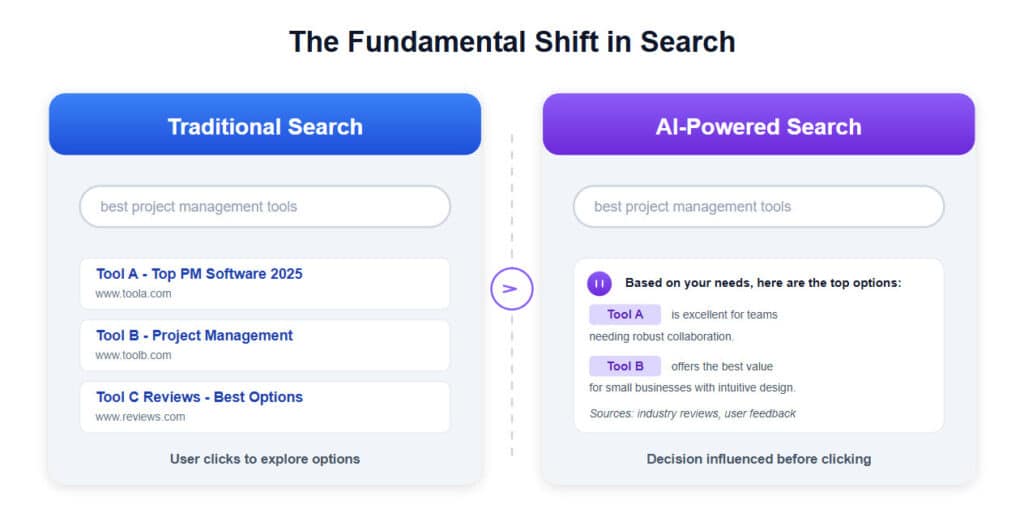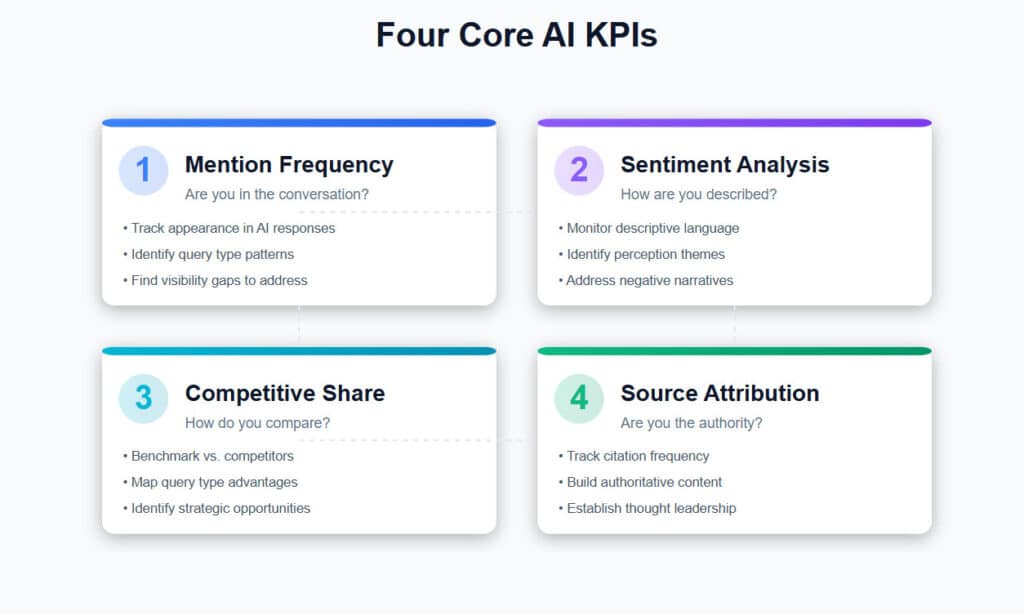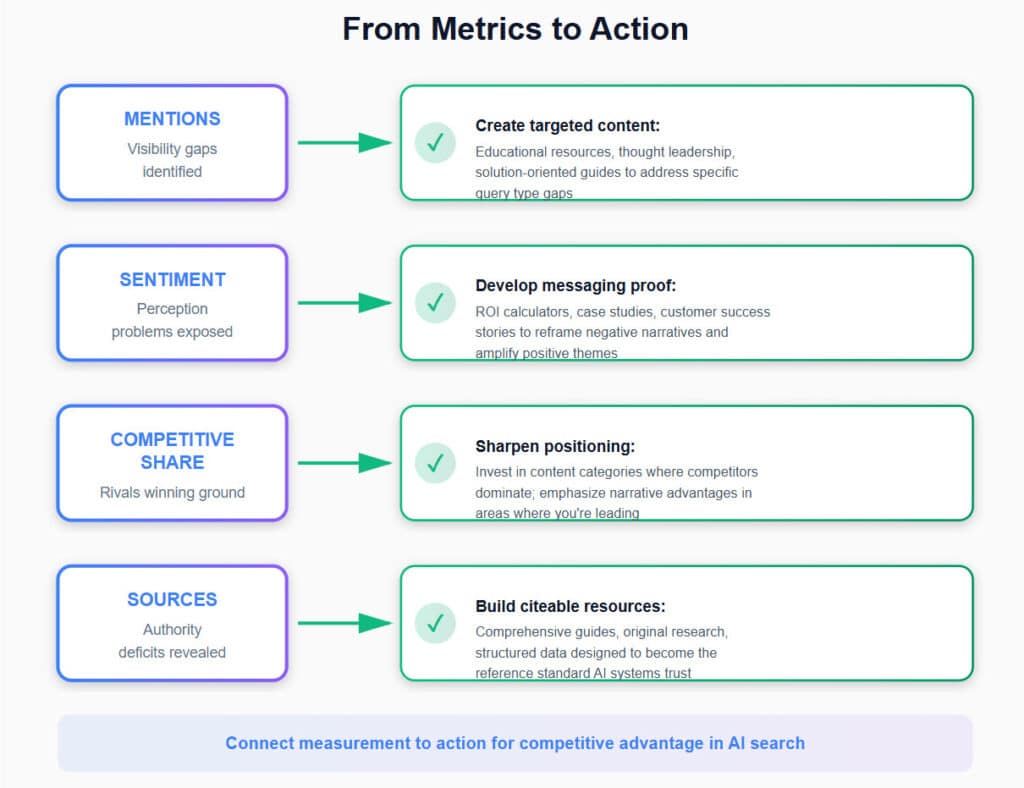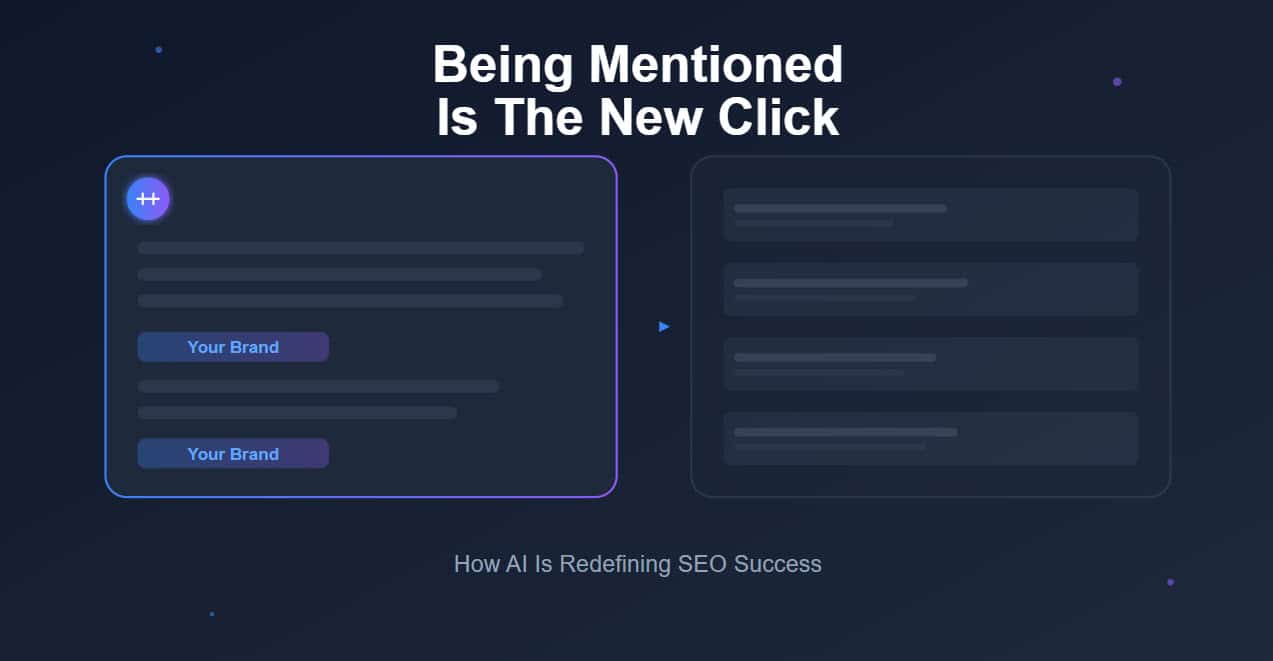How brands measure visibility, authority and market perception in the age of AI-powered search
For decades, SEO success was straightforward to measure. You tracked rankings, counted clicks, analyzed backlinks, and watched traffic flow into your site. If you appeared on page one of Google and captured the click, you controlled the conversation with your potential customer.
That playbook is being rewritten.
Large Language Models like ChatGPT, Claude, Gemini, and Perplexity are fundamentally changing how people find information and make decisions. Instead of clicking through a list of blue links, users now receive synthesized, conversational answers. Your brand is either part of that answer, or it doesn’t exist in that moment of consideration.
This shift demands a new framework for measuring SEO success. Being mentioned is the new click. And for businesses that want to stay relevant, understanding how to track and influence those mentions is no longer optional.
The Fundamental Shift In Search Behavior
Traditional search engines present options. AI systems make recommendations.

When someone asks ChatGPT for the best project management tools or asks Claude about cybersecurity solutions, they’re not getting ten blue links to evaluate. They’re getting a curated response that includes specific brands, framed in specific ways, with specific attributes attached.
If your brand isn’t mentioned in that response, you’ve lost the opportunity before it began. There’s no second page to rank on. There’s no ad space to buy your way into. You’re simply absent from a conversation that’s happening without you.
This is why content optimization for AI search has become critical. The content strategies that worked for traditional SEO aren’t enough anymore. You need to ensure your brand, your expertise, and your unique value are structured in ways that AI systems can recognize, understand, and reference.
Four KPIs That Define AI-Era Success
To navigate this new landscape, businesses need to track four core metrics that reveal not just visibility, but influence in AI-generated responses.

1. Mention Frequency: Are You In The Conversation?
The foundational question is simple but critical: when AI systems answer questions in your industry, are you mentioned?
If prospects are asking about solutions in your category and your brand never appears in the AI’s response, you’re invisible. It’s the equivalent of not ranking anywhere in traditional search, except the consequences are more severe because there’s no list of alternatives for users to scroll through.
But mention tracking isn’t just about counting appearances. The real insight comes from understanding the pattern of where you show up and where you don’t:
- Do you appear in educational “what is” and “how to” queries, establishing thought leadership?
- Are you mentioned in early-stage research queries or only in direct comparison queries?
- Do you show up when people ask about trends and innovations, or are you absent from those conversations?
These patterns reveal gaps in your content strategy. If you’re missing from educational queries, you need more thought-leadership content that positions you as a category expert. If you’re absent from solution-oriented queries, your differentiators aren’t clear enough or well-documented enough for AI systems to reference.
This is where an AI SEO compliance audit becomes invaluable. It helps you understand whether your existing content is structured and positioned to be discovered and cited by AI systems, and identifies the specific gaps that are keeping you invisible.
2. Sentiment Analysis: How Are You Described?
Being mentioned matters, but how you’re described determines whether that mention helps or hurts you.
AI systems don’t just list brand names. They add context, attributes, and qualifiers based on the information they’ve learned: “innovative but expensive,” “reliable but complex,” “emerging leader,” “legacy provider.” These descriptors shape perception in powerful ways.
Think of sentiment as the narrative around your brand that exists in the collective data AI systems have absorbed. If you’re consistently described as “enterprise-grade” but also “difficult to implement,” that tells you something important about how the market perceives you, and it suggests where your messaging needs work.
Actionable sentiment tracking means:
- Documenting the specific language used to describe your brand
- Identifying recurring themes in how you’re positioned
- Comparing your sentiment profile to competitors
- Noting whether descriptors align with your intended positioning
Negative sentiment patterns highlight urgent messaging gaps. If you’re framed as expensive, you need ROI calculators, pricing transparency, or case studies demonstrating value. If you’re described as complex, you need simplified onboarding content and customer success stories that prove ease of use.
Positive sentiment shows you what’s working and what to amplify. If you’re consistently called “trusted” or “reliable,” that becomes a central theme in your campaigns and customer communications.
Working with an experienced SEO consulting partner can help you develop a systematic approach to tracking and improving sentiment across AI platforms.
3. Competitive Share Of Voice: Context Is Everything
Knowing you’re mentioned 40% of the time means nothing without knowing how often your competitors appear.
Competitive share of voice measures your presence in AI responses relative to other players in your space. If you appear in 40% of relevant queries but your main competitor shows up in 75%, they’re winning the visibility battle. If you both appear equally often but their descriptions are glowing while yours are neutral, they’re winning the perception battle.
The strategic value comes from understanding the nuances:
- Which types of queries favor competitors over you?
- What attributes are they associated with that you’re not?
- Where are you leading that they’re weak?
- In head-to-head comparisons, how are you positioned relative to them?
This competitive intelligence transforms into a battle map for your content and positioning strategy. If competitors dominate certain query categories, that points to specific content investments you need to make. If their sentiment is consistently stronger, you need to double down on proof points, case studies, and differentiators.
A comprehensive content gap analysis can reveal exactly where competitors are out-investing you in content and where opportunities exist to claim territory they’ve neglected.
4. Source Attribution: Becoming The Authority
The ultimate measure of influence is source attribution. When AI systems cite your content as the basis for their answers, you’ve achieved something more valuable than a mention—you’ve established authority.
Source tracking reveals whose content AI systems trust enough to reference. If LLMs are citing your competitor’s research reports, industry publications, or third-party reviews rather than your own materials, it’s a clear signal: you’re not yet seen as the authoritative voice.
Building citeable authority requires:
- Publishing comprehensive, data-driven content that serves as definitive resources
- Creating structured content that AI systems can easily parse and reference
- Establishing expertise through consistent, high-quality thought leadership
- Earning recognition from credible third parties that AI systems respect
Think FAQ pages, original research, detailed guides, expert commentary, and well-attributed data. The goal is to create content so authoritative and well-structured that AI systems naturally turn to it when forming responses.
This is the highest level of optimization—moving beyond simply being mentioned to becoming the foundation of the answer itself.
From Metrics To Strategy
The danger with any new measurement framework is building elaborate dashboards that generate data without driving decisions. The value of AI KPIs isn’t in the tracking infrastructure; it’s in how you use the insights to shape strategy.
Each metric points to specific actions:

Mentions reveal visibility gaps → Create content that addresses those gaps, whether educational, solution-focused, or category-defining
Sentiment exposes perception problems → Develop targeted messaging, proof points, and customer evidence that reframe the narrative
Competitive share shows where rivals are winning → Identify and execute on opportunities to defend your position or attack their weaknesses
Source attribution reveals authority deficits → Invest in comprehensive, credible content designed to become the reference standard
The key is connecting measurement to action. Don’t just track mentions—analyze the pattern and fill the gaps. Don’t just note negative sentiment—create the content and proof that changes it. Don’t just observe competitive advantages—build the strategy to neutralize them.
This requires both technical expertise and strategic thinking, which is why many businesses partner with specialists who can not only conduct forensic SEO audits to understand what’s happening, but also architect comprehensive strategies to improve performance.
Why Early Movers Win
This feels unfamiliar because it is. The tools for tracking AI mentions aren’t standardized. There’s no universal dashboard. The best practices are still emerging.
That’s precisely why acting now creates disproportionate advantage.
Think back to the early 2000s when SEO was still experimental. Businesses that learned to optimize before best practices crystallized dominated search visibility for years. We’re at that same inflection point with AI search.
Waiting for perfect tools and established playbooks means letting competitors set the baseline while you play catch-up. The brands that figure this out now—even with imperfect measurement and evolving tactics—will establish positions that become harder to displace as the channel matures.
Starting doesn’t require sophisticated infrastructure. A simple process of running relevant prompts across AI platforms, documenting responses, and analyzing mentions, sentiment, competitive presence, and sources yields intelligence that can immediately inform your content and marketing strategy.
The New Definition Of SEO Success
Traditional SEO metrics—rankings, clicks, backlinks—aren’t obsolete. They still matter. But they no longer tell the complete story of your digital visibility.
Increasingly, your brand’s narrative is being shaped inside AI-generated responses before a potential customer ever visits your website. That’s where purchase decisions are being influenced, where brand perceptions are forming, where competitive positioning is happening.
Being mentioned is the new click. But the real competitive advantage comes from being mentioned favorably, being mentioned more often than competitors, and being cited as the authoritative source.
This requires rethinking content strategy, measurement frameworks, and what success looks like in SEO. It means tracking not just whether you appear in search results, but whether you appear in AI-generated answers. It means caring not just about traffic, but about how your brand is represented in the conversations happening at the earliest stages of the buyer’s journey.
For businesses ready to embrace this shift, the opportunity is significant. The brands that learn to influence AI-generated responses, that track and optimize for these new KPIs, that build content designed to be cited rather than just ranked—these are the businesses that will own visibility in the AI era.
At Expert SEO Consulting, we help businesses navigate exactly this transition. Whether you need an AI SEO audit to understand where you stand, content optimization to improve your presence in AI responses, or strategic SEO consulting to build a comprehensive approach, we’re here to ensure your brand doesn’t just survive this shift—it thrives in it.
The question isn’t whether AI will change how your customers find and evaluate solutions. That’s already happening. The question is whether you’ll measure and optimize for this new reality before your competitors do.
Ready to understand how your brand performs in AI-generated responses? Let’s talk about developing a measurement and optimization strategy that positions you for success in the AI era.






